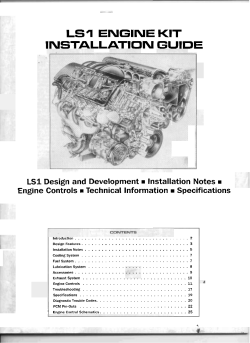
PLACA3D: A THREE-DIMENSIONAL CODE TO SIMULATE THE IRRADIATION BEHAVIOUR
PLACA3D: A THREE-DIMENSIONAL CODE TO
SIMULATE THE IRRADIATION BEHAVIOUR
OF DISPERSE/MONOLITHIC NUCLEAR FUEL
FOR RESEARCH AND TEST REACTORS
Alejandro Soba, Alicia Denis
Code & Models-CNEA
Argentina
IGORR 2014, Bariloche, Argentina.
A little of History
• DIONISIO Code 1.0: Power Reactors (1997-2007)
• PLACA 2D, Disperse fuel (2002-2007)
• PLACA 2D, Monolithic fuel (2002-2007)
• PLACA 2D, +Gap (2002-2007)
…. 2010
• DIONISIO 2.0 Re engineering of the code. As part
of the same structure:
PLACA 2D/3D: for Disperse/Monolithic, and try
the presence of gap (at the moments in 2D)
Modelling in 3D
Dispersed plate type
fuel
Monolithic plate type
fuel
Models included in PLACA3D
Temperature distribution:
The heat diffusion equation is solved in each plate
material in Cartesian coordinates
T
T
T
y , j
z, j
x, j
Hj 0
x
x y
y z
z
j thermal conductivity
j=core, gap (if present), cladding
H max cos( z / le ) , j fuel
Hj
0 , other material
Models included in PLACA3D
Stress-strain:
The problem is solved in each phase assuming plane
strain
{e} {} {th } { sw}
{} { E } { P }
{} D{}
D material matrix;
Thermal expansion; Swelling;
Elastic and plastic strain
Calculation procedure
The termo-mechanical equations are solved by the finite
element method.
Hexahedrical elements with bilinear interpolation are used.
Within each FE a representative unit cell is defined.
Temperature and power history are assumed uniform there.
In disperse fuels the unit cell contains the particle, the
interaction layer, porosity and the matrix, according to the
volume proportions in the material.
Fission gas release is solved by the FEM in a
representative spherical grain.
Interaction U-Mo / Al
The growth of an interaction layer between the fissile
compound U-Mo and the aluminum matrix is
observed.
Its presence produces a significant increase of the
fuel operation temperature and swelling, which may
lead to plate failure.
The interaction layer growth is a diffusion controlled
process, which depends on the surface-volume
relation of the fuel particles with respect to the matrix.
Interaction U-Mo / Al
(U-Mo)Al4.4
(U-Mo)Al3
ClU/ a
ClAl
/a
U-Mo
a/l
ClAl
/m
Ci Di n Ci
r
n
t
r
r
r
ClU/ m
layer
Al
l / m
The concentration
profiles of U(Mo)
and Al obey
n=0 rectangular,
n=2 spherical
symmetry
Interaction U-Mo / Al
Two moving boundary equations:
Al
C
d a / l
Al
l
(ClAl
)
D
/a
l
dt
r
U
C
dl / m U
l
Cl / m DlU
dt
r
DlU , DlAl
a / l
l / m
interdiffusion coefficients of U and Al in
the interaction layer
Interaction U-Mo / Al +Si
0 wt% Si
0.2 wt% Si
0.5 wt% Si
1 wt% Si
2 wt% Si
4 wt% Si
6 wt% Si
14
12
10
8
14
6
Ideal Case
IL size
12
10
4
Numerical
IL size
Model of IL grow
included in
PLACA3D.
Comparison with
experiments.
2
Low Si Zone
8
6
High Burnup Zone
4
2
0
0
0
20
40
60
235
Rich Si Zone
0
Y 2 A%wtSi B(burnup) f0.75 1.625 - %wtMo6.25 exp 9600
1.96T
%wtSi
%wtSi
%wtSi
A%wtSi 0.68 exp
1.69 exp
0.024 exp
0.327
0.14
8.71E 12
B(Burnup) 0.274 exp(0.0813 * burnup)
Burnup ( U)
2
4
6
8
Measured
80
10
12
14
Results (cont)
E Ideal Case
FUTURE & EFUTURE
IRIS & IRIS.TUM
RERTR3 & RERTR5
1,0
Numerical
0,8
+0.1
-0.1
vol% Al
vol% Compound
vol% Intermetallic
0,6
0,4
0,2
0,0
0,0
0,2
0,4
0,6
Measured
0,8
1,0
Experiment: IRISx,
IRIS-TUM,
FUTURE, EFUTURE, RERTR3
& RERTR5
Results (cont)
500
T (°K)
450
T sup (°K)
T Central (°K)
(Exp) T cen Efut 4
(Exp) T cen Efut 6
PLACA T cen Efut 4
PLACA T cen Efut 6
0
10
20
30
40
50
time (days)
60
+5%
Ideal Case
500
-5%
70
80
Numerical
400
Simulation with
PLACA3D of the
experiment EFUTURE
400
400
500
Measured
Results (cont)
20
15
Numerical
Ideal Case
FUTURE
IRIS
RERTR-3
RERTR-5
+20%
-20%
10
5
0
0
5
10
Measured
15
20
Simulation with
PLACA3D IL size
Conclusions
The results obtained with PLACA3D are in good agreement with
the PIE data of the experiments FUTURE, IRIS-x, E-FUTURE
and RERTR-3-4-5-6.
The modular structure of PLACA3D allows testing and
replacement of the models included.
The inter diffusion model included in PLACA3D, that solves a
double Stefan problem, gives to the code a realistic tool. The
consumption of fuel particles and matrix is strongly dependent
on the longitudinal position of each finite element, i.e., on the
power history and the consequent temperature distribution.
PLACA3D: A THREE-DIMENSIONAL CODE TO
SIMULATE THE IRRADIATION BEHAVIOUR OF
DISPERSE/MONOLITHIC NUCLEAR FUEL FOR
RESEARCH AND TEST REACTORS
Thanks you!
© Copyright 2025







![arXiv:1504.05834v1 [math.PR] 22 Apr 2015 - Université Paris](http://cdn1.abcdocz.com/store/data/001599011_1-f13c320d801f617671df799968c79502-250x500.png)


